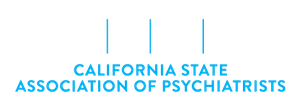Prescribing Issues (Continued)
From CSAP’s Government Affairs Committee Chairwoman Emily Wood:
CSAP remains committed to:
- Protecting the treatment decisions that are made in collaboration between a patient and their psychiatrist
- Supporting legislation and regulations that emphasize substance misuse prevention and treatment
- Parity of mental health and substance use care with other types of medical health care
- Equity, justice, and inclusion in the provision of behavioral health care

The opioid epidemic has wreaked havoc on communities across the country. In the last several years, >50,000 people have died each year from opioid overdose alone. The rates of overdose involving most drugs, including synthetic opioids, psychostimulants, benzodiazepines, and antidepressants, have increased over the last 20 years. >99% of psychostimulant-involved overdoses are with methamphetamine or cocaine and the vast majority in the last several years have been in combination with synthetic opioids. Benzodiazepine and antidepressant-involved overdoses have risen almost exclusively due to combinations with synthetic opioids.
While synthetic opioids, medications that are rarely prescribed by psychiatrists, are the main culprits in recent overdose deaths, there is mounting evidence that pharmaceutical distributors are cracking down on all controlled substances using opaque algorithms designed to detect misuse. In turn, with limited supplies, pharmacies are denying prescriptions based on fabricated laws such as geographic distance between provider and patient. This process disproportionately targets psychiatric patients and psychiatrists since the vast majority of controlled substances are psychoactive drugs. Therefore, the current man-made drug shortages can be considered an issue of behavioral health parity with other types of medical health care.
Furthermore, we know that shortages are bound to most negatively impact those individuals in our society who are already suffering bias, stigma, discrimination, oppression, and systemic harm. In Los Angeles, one adolescent with ADHD whose family is able to pay cash for psychiatric visits will always manage to get stimulant medication, regardless of shortage. Their parents can spend whatever it takes to drive to multiple pharmacies until they find one with the right formulation. However, it may not be as easy for another adolescent with ADHD who dutifully takes two buses each way to the DMH clinic every month.
For these reasons, we continue to request that you provide data via our survey on prescribing issues that you and your patients are experiencing. We are getting close to having enough data to present to APA.
CSAP Prescribing Issues Survey
You can use this form multiple times to report on different issues. The form also has plenty of space for prose responses. You can also email issues to Paul@syaslpartners.com.
DEA Guidance
A newly approved guidance document has been posted to the DEA Guidance Document Portal and Question & Answers section. This guidance document clarifies that neither the Controlled Substance Act nor DEA regulations establish quantitative thresholds or place limits on the volume of controlled substances DEA registrants can order and dispense; and reminds all DEA registrants of the requirement to establish systems to identify and report suspicious orders of controlled substances to include Medication for Opioid Use Disorder (MOUD). You may view Suspicious Orders Q&A here.
SYASL has opened a dialogue with lobbyists in California who represent the large drug store chains as well as retailers in general. Next week, this group will meet to discuss the issues raised by many of you. In the meantime, this may be of interest: Walgreens’ Secret Checklist for Pain Meds.

